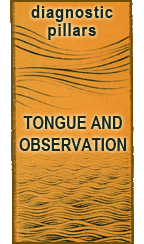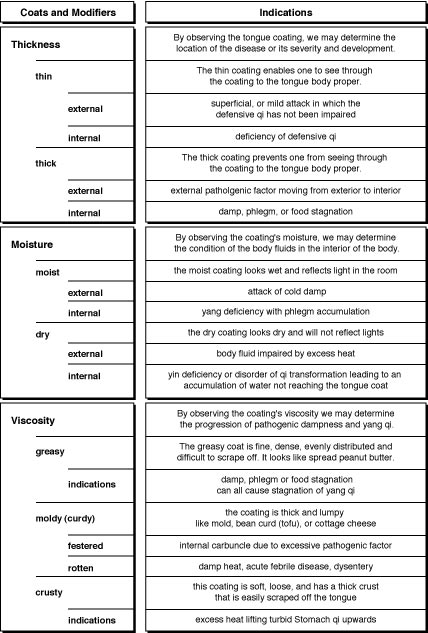Tongue Coating Thickness Moisture and Viscosity

Indications associated with tongue coating thickness, moisture, and viscosity.

By observing the coating’s viscosity we may determine
the progression of pathogenic dampness and yang qi.
excess heat lifting turbid Stomach qi upwards
damp heat, acute febrile disease, dysentery
internal carbuncle due to excessive pathogenic factor
this coating is soft, loose, and has a thick crust
that is easily scraped off the tongue crusty
the coating is thick and lumpy
like mold, bean curd (tofu), or cottage cheesemoldy (curdy)
festered
rotten
damp, phlegm or food stagnation
can all cause stagnation of yang qi
The greasy coat is fine, dense, evenly distributed and
difficult to scrape off. It looks like spread peanut butter.
Viscosity
greasy
By observing the coating’s moisture, we may determine
the condition of the body fluids in the interior of the body.
yin deficiency or disorder of qi transformation leading to an
accumulation of water not reaching the tongue coat
body fluid impaired by excess heat
the dry coating looks dry and will not reflect lightsdry
external
internal
yang deficiency with phlegm accumulation
attack of cold damp
the moist coating looks wet and reflects light in the room
Moisture
moist
external
internal
By observing the tongue coating, we may determine the
location of the disease or its severity and development.
damp, phlegm, or food stagnation
external pathogenic factor moving from exterior to interior
The thick coating prevents one from seeing through
the coating to the tongue body proper.thick
external
internal
deficiency of defensive qi
superficial, or mild attack in which the
defensive qi has not been impaired
The thin coating enables one to see through
the coating to the tongue body proper.
Thickness
thin
Indications Coats and Modifiers
external
internal
indications
indications
the progression of pathogenic dampness and yang qi.
excess heat lifting turbid Stomach qi upwards
damp heat, acute febrile disease, dysentery
internal carbuncle due to excessive pathogenic factor
this coating is soft, loose, and has a thick crust
that is easily scraped off the tongue crusty
the coating is thick and lumpy
like mold, bean curd (tofu), or cottage cheesemoldy (curdy)
festered
rotten
damp, phlegm or food stagnation
can all cause stagnation of yang qi
The greasy coat is fine, dense, evenly distributed and
difficult to scrape off. It looks like spread peanut butter.
Viscosity
greasy
By observing the coating’s moisture, we may determine
the condition of the body fluids in the interior of the body.
yin deficiency or disorder of qi transformation leading to an
accumulation of water not reaching the tongue coat
body fluid impaired by excess heat
the dry coating looks dry and will not reflect lightsdry
external
internal
yang deficiency with phlegm accumulation
attack of cold damp
the moist coating looks wet and reflects light in the room
Moisture
moist
external
internal
By observing the tongue coating, we may determine the
location of the disease or its severity and development.
damp, phlegm, or food stagnation
external pathogenic factor moving from exterior to interior
The thick coating prevents one from seeing through
the coating to the tongue body proper.thick
external
internal
deficiency of defensive qi
superficial, or mild attack in which the
defensive qi has not been impaired
The thin coating enables one to see through
the coating to the tongue body proper.
Thickness
thin
Indications Coats and Modifiers
external
internal
indications
indications
More tongue diagnosis charts:
Tongue coatings
- Tongue coating colors
- Tongue coating – thickness, moisture, viscosity
- Tongue coating – distribution and root
Tongue body flexibility
- Tongue body movement – limp, stiff, trembling
- Tongue body movement – deviated, short, licking, curving
Tongue body color
- Tongue body color – pale, red, crimson, purple, blue
- The pale tongue body, and the pink tongue body
- The red tongue body
- The crimson (red-purple) tongue body
- The purple (and green-purple) tongue body
This page links to sample charts from the Traditional Chinese Medicine Diagnosis Study Guide by Yi Qiao, L.Ac., and Al Stone, L.Ac., DAOM. Buy it now or check out the sample pages at Eastland Press.
 Last modified: August 16, 2009
Last modified: August 16, 2009  Tags: Diagnosis, Observation В· Posted in: Tongue-Observation
Tags: Diagnosis, Observation В· Posted in: Tongue-Observation
